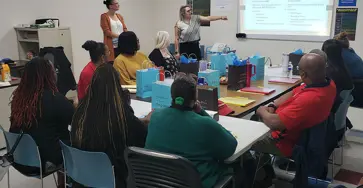
What exactly does it take to become a member of GEO’s elite air mission flight team? We asked Jatinder Singh, Information Systems Specialist at Tacoma ICE Processing Center in Tacoma, Washington. He is a ten-year GEO employee, and is in his sixth year with the flight team.
First of all, it’s not a job you apply for. Individuals are recommended to the air mission flight team by the Warden and Associate Warden of each facility. Potential candidates must exemplify the professional discipline and demeanor required for the post. It takes team work, dedication and focus to carry out flight missions. A typical mission involves waking at 2:45 am, arriving at the tarmac, inspecting the plane, organizing inmate property, and verifying the plane is provisioned with food and water. Once inmates are seated and on their way, team members are constantly moving through their assigned areas, checking restraints at regular intervals, providing escorts to the restroom, distributing meals, and making sure everything runs smoothly. Singh smiles and says there is no clock watching or boredom. At the completion of a mission, it is not uncommon for 16-18 hours to have passed. It takes everyone pulling together to ensure a safe, successful mission.
Safety and security are top priorities when transporting inmates by air. Two days before the mission, team members travel from around the country to the mission departure point. Singh has flown ten missions from state and federal facilities in Arizona, Kentucky, Alaska, Michigan and Colorado. The day before mission departure, team members spend time in briefings, visit the facility, collect all necessary paperwork, and review inmate profiles. Knowing each inmate’s history is critical in developing the safest seating arrangements possible for the flight. Each team member is assigned specific duties and areas of responsibility. Just before takeoff, Scott Fitch, Officer in Charge for air missions and Associate Warden at New Castle Correctional Facility, comes aboard to address inmates regarding what is expected of them during transport.
The most common tools used by team members to manage inmate behavior are IPC (Interpersonal Communication) skills. Good two-way communication with inmates is the best way to de-escalate most situations. In-flight movies serve as an effective distraction tool to keep inmates occupied.
When asked what makes this work rewarding, Singh replies, “I love everything about the team including the members and leaders. We are like a family. I am proud every time a mission ends successfully. You don’t get to do it every day. It’s a privilege to be part of it. You sacrifice your family time, but at the end of the day, you know you have done what you trained for.” He likes how his 5-year-old son sums up his air mission work, “My dad takes the bad guy to the jail.”

